| 1 | Hairy bush viper |
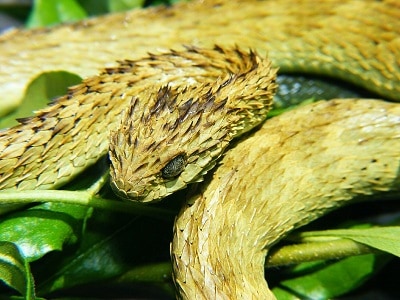
If you’re exploring the jungles of Uganda, and the forest suddenly “comes alive” and bites your arm, you haven’t found the world’s first tree with teeth. You’ve actually encountered the hairy bush viper (Atheris hispida), a venomous snake which perfectly mimics foliage.
This species measures 40-60cm and is common across central African forests, where it tends to cling to low branches and the tops of bushes, 1-2 metres above ground. It has sharply vertical pupils and elongated scales which give it the appearance of a pineapple. Any tourist has a strong chance of meeting the hairy bush viper, unless they stay in the comfortable confines of their Kampala hotel, not daring to even put one foot in the countryside.
Hairy bush vipers have supreme disguise, and even if you’re aware of their existence, it’s hard to spot one until you’re right next to it. The foliage suddenly shifts, a pair of yellow eyes opens, and the only determiner of your fate is what mood the snake is in that day. Atheris hispida can blast from their branch, striking arm and chest in mere milliseconds. Their venom is primarily cytotoxic, rarely killing but causing swelling and necrosis.
| 2 | Bothriechis guifarroi |
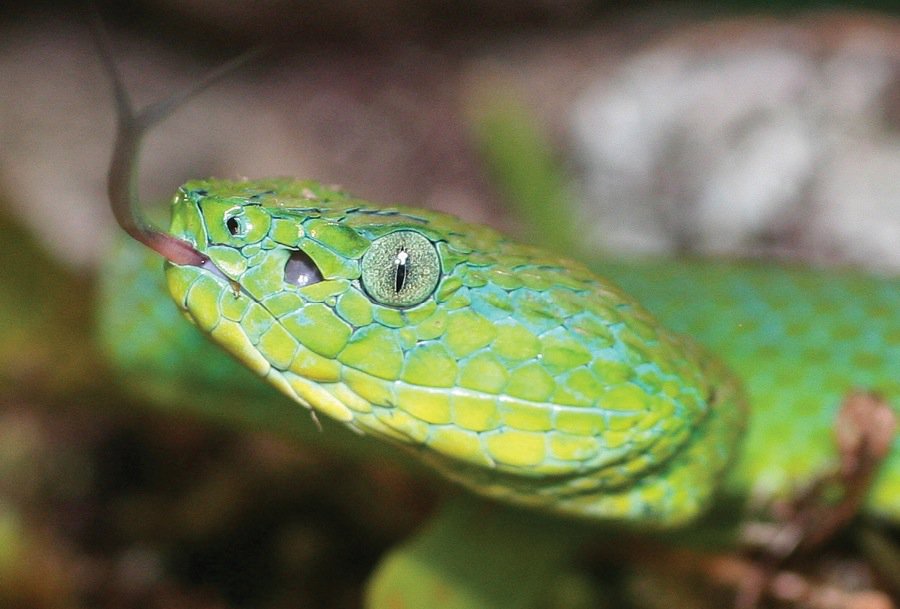
This species is a central American ecological parallel of Atheris hispida, albeit with a 9/10 disguise rather than 9.9/10. Bothriechis guifarroi also likes to rest on branches, and also likes to give a false impression of a sloth-like personality. There’s no hint of its capability for rapid, jabbing lunges when you see this snake 2 metres high on a tree. That all changes when they feel harassed. Poke them, yell at them, or simply stray too close, and Bothriechis guifarroi will activate. All the gears of serpent machinery will click into place, producing a lightning fast jab that unfolds in mere milliseconds.
It takes great preparation to dodge this strike, not to mention reaction times. Bothriechis guifarroi has no need for intricate calculations about angles. Its lunge comes from instincts fine-tuned over millions of years of evolution, just as California kingsnakes are fine-tuned constricting machines.
Bothriechis guifarroi is found in northern Honduras, and is the far less common cousin of the eyelash viper. It was only discovered in 2010, so there are no case studies on bites. However, their eyelash viper cousin has cytotoxic, haemotoxic venom which occasionally kills people.
| 3 | Snouted cobra |

Cobras are rapid in everything they do: slithering, flecking their tongues, crossing a river to investigate an intriguing mammal smell. They even swallow prey quickly, gulping down a mouse before forgetting instantly and moving onto their next meal.
Cobras have an exceptionally rapid lunge and the snouted cobra is no exception. This species lives in northeast South Africa and Zimbabwe, while the cape cobra inhabits the rest of South Africa. As they favour open spaces like grassland and hills, they’re normally easy to see coming. But if you turn round the corner of a hiking trail and meet one face to face, you’re in much more trouble. It depends on the snouted cobra’s precise mood that day. It may let out a piercing hiss, then flee into the undergrowth before a thought can enter your head. Alternatively, it may be cocky and confident and decide that attack is the best form of defence.
Snouted cobras can make a series of jabbing, rapid strikes, repeated at short intervals. Their infamous chest raise (complete with neck flare) brings them close to the target before combat has even begun. It’s wise to back off slowly, then run, or perhaps use your rucksack as a shield.
| 4 | Kuri buri pitviper |
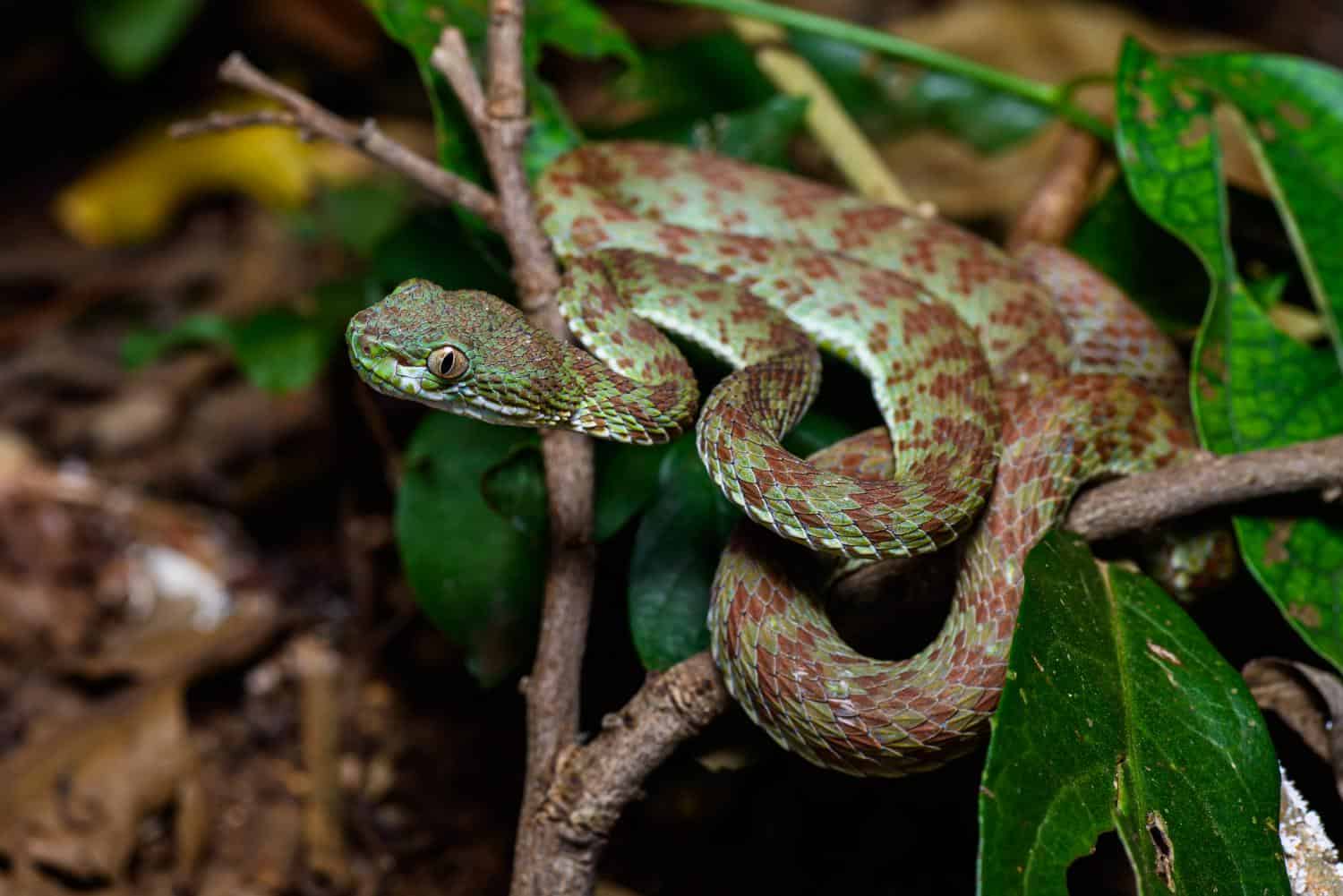
The Trimeresurus pitvipers of southeast Asia number 44 as of 2023, and every single one is venomous. They all possess true venom glands, injected in mere milliseconds, with venom glands connected directly to their front fangs via ducts. Some species like the white-lipped pitviper are common all over Thailand, but some rule smaller enclaves of mountain forests. Kuri Buri pitvipers are found only in Prachuap Khiri Khan province, southern central Thailand, and if you enter their domain without their goodwill, there’s no telling what fate awaits you.
This is a nocturnal branch dweller, hard to spot at the best of times with their complex patterns. At midnight, with the smothering roof of the jungle canopy blocking out all traces of light, the task becomes even harder. Stumbling around with a torch, you may accidentally draw close to a branch holding a Kuri Buri pitviper. A piercing hiss may let out, followed by a savage jab of a strike, before you have any time to react.
Trimeresurus kuiburi is a relatively thin snake and there’s little risk of being knocked over. The worst thing is the dawning realisation that there’s now Thai pitviper venom flowing through your body. Bites from this species tend not to kill, but cause local cytotoxic effects like swelling and necrosis.
| 5 | Central American tree snake |
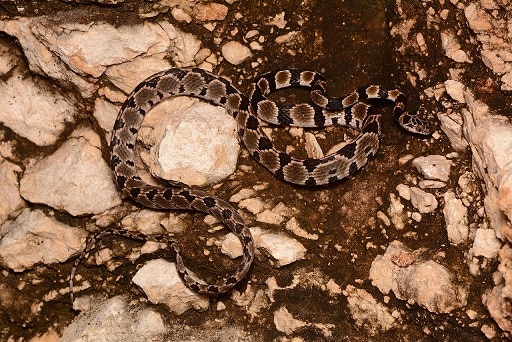
A mildly venomous snake, but still one that can knock your perfectly planned day off course. Central American tree snakes range from southern Mexico to northeast Colombia, inhabiting Costa Rica and Guatemala alike. They’re found in deciduous forests on slopes of the Pacific, as well as tree clumps in more open areas.
They reach 93cm, and a thin nimble body allows them to cross tree branches with ease. It also allows them to strike rapidly, giving them agility rather than a single crushing lunge. Imantodes gemmistratus can lunge from their branch perch and fasten their teeth onto your arm. They’ll then chew steadily over 2-3 minutes, to manually massage a rear-fanged venom into the wound.
The exact strength of Imantodes gemmistratus venom is a mystery, but several “harmless” snakes have proved surprisingly potent recently. A man bitten by a western hognose snake for over 10 minutes ended up with a noticeably swollen hand. Such chewing snakes can prove very difficult to dislodge. Central American tree snakes are recognisable by their huge eyes, designed to spot lizards on distant branches. They’re mainly a harmless member of the Costa Rican ecosystem, but don’t give them a chance to prove otherwise.
| 6 | Coastal taipan |

The coastal taipan is notorious for invading sugar plantations, on a determined quest to eat the rodent pests lurking there. They’re equally notorious for their fast, jabbing strikes, and their ability to retreat and suddenly reappear. This is a venomous Australian species found along the northern coast, particularly in Queensland. They like grassland, open woodlands, and occasionally urban areas, avoiding dense forests.
Coastal taipans reach 2 metres, and their venom is potentially lethal. A coastal taipan bite could cause respiratory failure and weak muscles, even paralysis. To avoid this fate, spot them before it’s too late. Always keep an eye out for coastal taipans roaming around, and dodge them before you get into a close encounter.
As the top mammal-eater of Australian snakes (along with inland taipans), their rapid lunge has a solid explanation. Rats have vicious, gnawing teeth, and to hunt them, a coastal taipan must rapidly inject venom, followed by an immediate withdrawal, lest they suffer vicious wounds to their bodies. Coastal taipans then stalk their prey stealthily while slowly succumb.
| 7 | Habu |
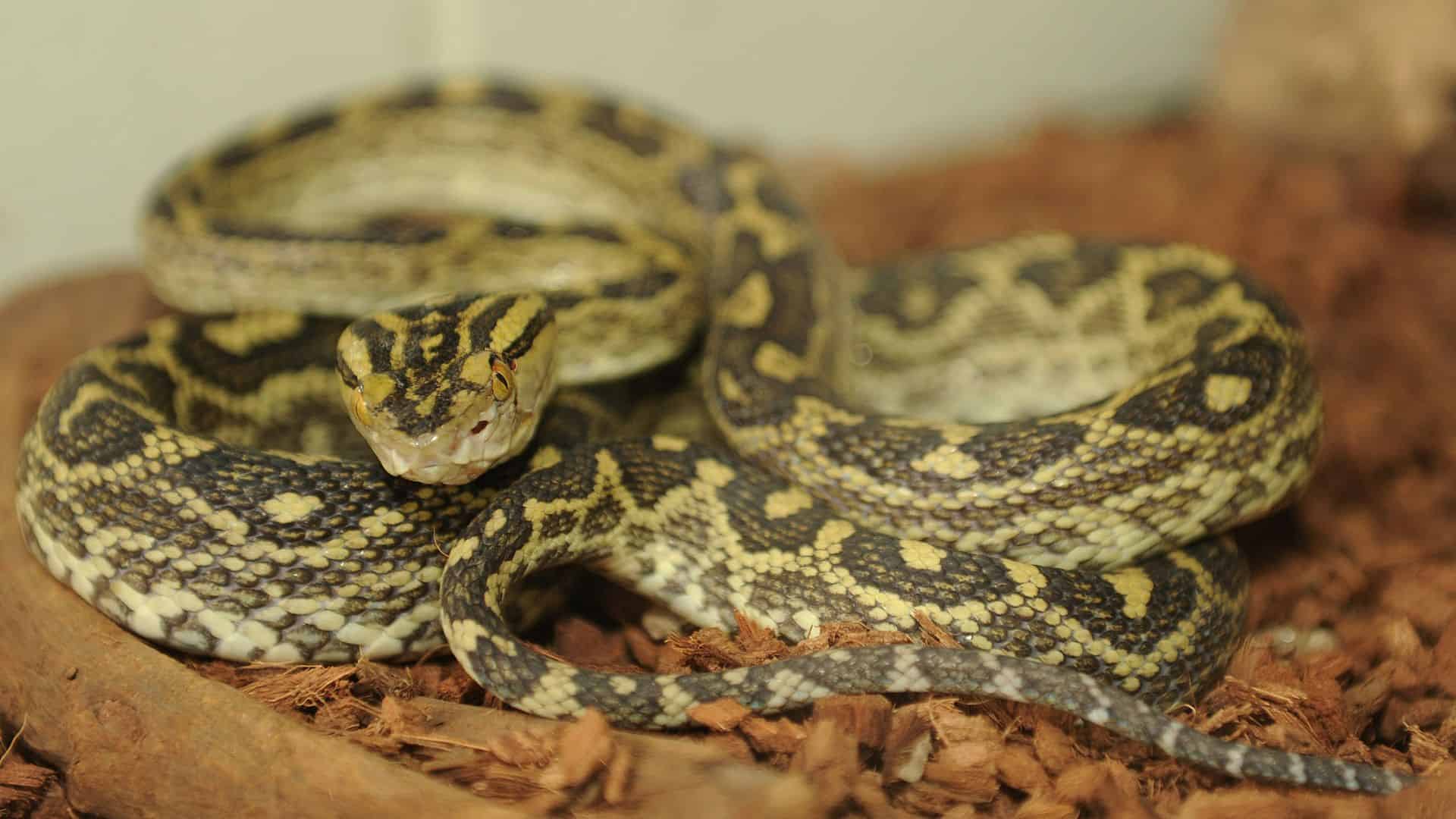
The habu is an icon of fear in Japan. The mention of a habu bite, with its necrosis and spontaneous bleeding, can send shivers down anyone’s spine. This species lurks in forests on the edges of villages, and its rapid lunge makes the fear factor infinitely worse. A habu can spring on a forest explorer from nowhere, giving them a fraction of a second to dodge.
This species sticks to forest floors rather than 2 metre high branch perches. They measure 120-150cm, and have brown-beige scales that blend perfectly with fallen leaves and soil rather than green foliage. The habu rarely kills, but leaves 6-8% of victims with permanent disabilities. Many are scared of entering forests because of them.
The good news is that a pair of wellies or high boots are likely to be protective, as they typically strike from a ground position. While the strike is rapid, you may simply feel one thud against your footwear. Habus are particularly common on the island of Okinawa, where they coexist with mamushis and tiger keelbacks, which are also dangerously venomous.
| 8 | Totonacan rattlesnake |
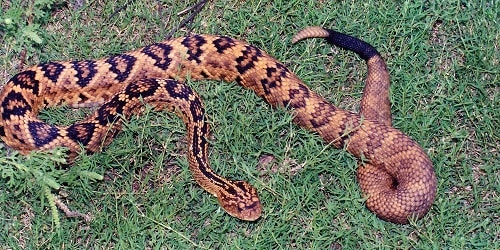
The Totonacan rattlesnake inhabits a large swathe of central Mexico, in a variety of habitats including grassland, woodland, and semi-desert scrub. With sharply contrasting beige-black patterns, this is an easy serpent to spot. But what if you’re completely absorbed in your map, flicking through your phone, or lost and trying frantically to remember the route to your car? You could easily meet the Totonacan rattlesnake in your distraction, lurking behind a bush.
In your shock, you may not have time to react, as like many rattlesnakes, this species has a rapid lunge. Totonacan rattlesnakes can strike at calves, ankles and thighs with little effort. Its venom is poorly researched, and assumed to contain cytotoxins and haemotoxins which cause spontaneous bleeding. If you’re a few metres away, it will unleash the usual repertoire of hissing and shaking a musical rattle to warn you of its presence. This should give you time to back off. If you’re inches away, you’re already well inside the borders of the red alert danger zone.
Luckily, Totonacan rattlesnakes move relatively slowly (except when striking). This species primarily eats mammals, and has a particular liking for squirrels.
| 9 | Black-headed catsnake |
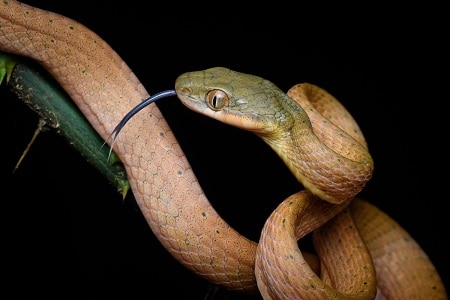
Catsnakes are a classic family whose venom was underestimated for decades. While they fail to match cobras, the Boiga catsnake genus (38 members) are among the more potent of the rear-fanged chewing snakes. The black-headed catsnake (Boiga nigriceps) lives in southern Thailand and peninsular Malaysia. It’s easily distinguishable from the common green catsnake by its pale body and dark head. It measures 100-150cm, and anyone who meets Boiga nigriceps will get to witness these characteristics up close, as it performs a frenzied lunge from its branch perch.
Though reasonably lazy, black-headed catsnakes hate being disturbed. Their strikes are accurate and rapid, typically coming from an ambush position 2 metres above ground. Black-headed catsnakes will lodge onto your skin and commence chewing, and should be dislodged as rapidly as possible before the venom has a chance to infiltrate the bloodstream.
A recent study found genetic transcripts for three-finger toxins in black-headed catsnake venom, which are typically neurotoxins, and their cousin the gold-ringed catsnake has a neurotoxin called boigatoxin-A, which may be the one identified in black-headed catsnakes. Three-finger toxins are the neurotoxic class which make coral snakes so deadly. Walk past the black-headed catsnake and grant them respect, and you’ll easily get away with it (unless you bump straight into a cobra afterwards).
| 10 | Neotropical whipsnake |
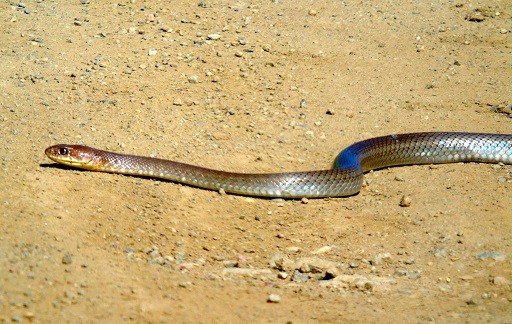
A fast-moving snake of Central America which is closely related to the US coachwhip. Neotropical whipsnakes reach 252cm and avoid dense forests, speeding through savannahs, grassland and bushy areas. Neotropical whipsnakes tend to ignore humans. Their speed and agility give them all the confidence they need. But if provoked, their strike can be rapid, coming in the form of a sharp jab rather than a crushing pounce.
While neotropical whipsnakes were once assumed to be non-venomous, the fact that they chew their lizard prey’s head for several minutes before swallowing offered evidence to the contrary. Confirmed prey include silky anoles and fellow snakes like road guarders. Don’t provoke the neotropical whipsnake, and there’s almost no chance of feeling their wrath.
It’s possible to live in complete harmony with this snake, sitting on a bench watching birds while they slither harmlessly past your feet. The exact properties of their mild venom are a mystery. It could contain cytotoxins to predigest prey, or even neurotoxins to paralyse tiny creatures. This would be diluted in humans and likely cause nothing more than twitching eyelids.
